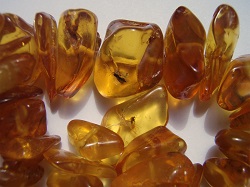A- |
B- |
C- |
D- |
E- |
F- |
G- |
H- |
I- |
J- |
K- |
L- |
M- |
N- |
O- |
P- |
Q- |
R- |
S- |
T- |
U- |
V- |
W- |
X- |
Y- |
Z |
AMBER:Uses: Ornamental stone, gemstone and semi-precious stone.Amber is a beautiful stone that is cut and polished and used as a valuable gemstone. It is very light in weight which allows it to be used in a large jewelry piece without discomfort. Amber, or fossil tree sap, has been known since antiquity. A fossil itself, it can contain many preserved insects and other animals and plants that are tens of millions of years old. These frequent fossil inclusions were made famous in the movie "Jurassic Park". The odd inclusions that are often seen in amber usually add to amber's unique look and in many cases greatly increase its value. The fossils that are encased in amber probably got there when they flew or crawled on to the fresh seeping sap and then got stuck. The sap oozed over the trapped animals and perhaps fell to the ground and was later covered by dirt and debris. The sap later hardened and became a fossil. The fossils are mostly insects such as gnats, flies, wasps, bees and ants. Occasionally more exotic insects are trapped in the amber such as grasshoppers, preying mantises, beetles, moths, termites, butterflies, etc. Other non-insect animals are found in amber too such as spiders, centipedes, scorpions and even frogs and lizards. No really large animals like mammals or birds are seen in amber but feathers and fur have been seen. Invaluable plant remains have also been found in amber including flowers, mushroom caps, seeds, leaves, stems, pine needles and pine cones. The rarity of the trapped fossils controls the value of the amber more so than the quality of the amber. Remember these are fossils and are not the same species that are alive today. Amber has greatly increased the knowledge of the evolution of insects and plants as well as enlivening the interest in paleontology in general. |

